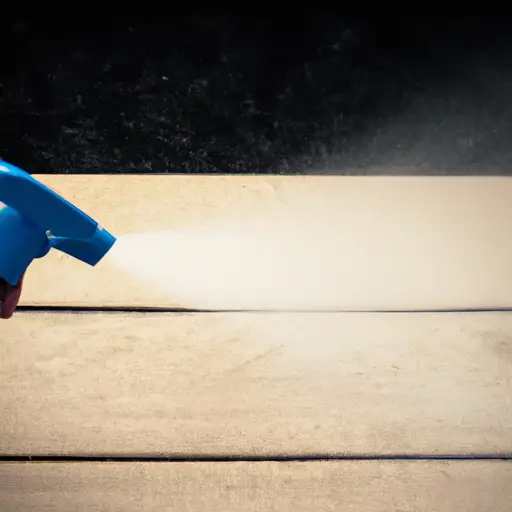If you’re looking to tackle a wood staining project and wondering whether a sprayer is the right tool for the job, you’ve come to the right place! In this article, we’ll explore the benefits and considerations of using a sprayer for staining wood. From achieving a smooth and even finish to saving time and effort, discover why a sprayer might be the perfect solution for your next woodworking venture. So, put on your DIY hat, and let’s dive into all things sprayer and wood staining!
Can I Use A Sprayer For Staining Wood?
Table of Contents
Safety Precautions
When working with a sprayer to stain wood, it’s important to prioritize safety. By taking the right precautions, you can ensure a safe and enjoyable experience. Let’s explore some key safety measures you should consider.
Choosing the Right Sprayer
Selecting the appropriate sprayer is crucial for achieving optimal results and personal safety. Research different types of sprayers and choose one that is specifically designed for staining wood. This will ensure that the sprayer is compatible with the viscosity of the stain and delivers an even application.
Wearing Protective Gear
Protective gear is essential to shield yourself from potential hazards during the staining process. Always wear gloves to protect your hands from the staining chemicals. Additionally, make sure to wear safety goggles to prevent any splatters from reaching your eyes. Lastly, use a respiratory mask to avoid inhaling any harmful fumes.
Preparing the Work Area
Before starting the staining process, it’s essential to prepare your work area properly. Clear the space of any items that may obstruct your movement and cover the surrounding surfaces with drop cloths or plastic sheets to prevent any accidental staining. This will ensure that you have a clean and organized workspace, reducing the risk of accidents.
Preparation
Proper preparation is the key to achieving a flawless finish when staining wood. By following these steps, you can ensure that your project turns out beautifully.
Selecting the Stain
Choosing the right stain is crucial in determining the final look of your wood. Consider the type of wood you’re working with and the desired outcome. There are various types of stains available, ranging from transparent to solid color options. Take the time to do research and select a stain that suits your needs.
Preparing the Wood Surface
Preparing the wood surface is essential to ensure that the stain adheres properly and provides a smooth finish. Start by cleaning the wood with a wood cleaner or mild detergent to remove any dirt, grease, or old finishes. Next, sand the surface to create a smooth and even texture. Make sure to remove any dust or debris before proceeding to the staining process.
Testing the Sprayer
Performing a test of the sprayer before starting the actual staining process is highly recommended. This will allow you to familiarize yourself with the equipment, assess the spray pattern, and adjust the settings if needed. Use a small piece of scrap wood to test the sprayer and ensure that it provides the desired coverage and finish.
Using the Sprayer
Now that you’ve prepared your work area and selected the appropriate stain, it’s time to start using the sprayer. Follow these steps to achieve a professional-looking finish.
Setting Up the Sprayer
Before filling the sprayer with stain, carefully read the manufacturer’s instructions and assemble the sprayer accordingly. Ensure that all connections are secure and that the sprayer is in good working condition. Fill the sprayer with the appropriate amount of stain, following the instructions provided by the stain manufacturer.
Adjusting the Nozzle
The nozzle plays a significant role in determining the spray pattern and coverage of the stain. Adjust the nozzle settings according to your desired application. For a larger area, choose a wider spray pattern, while for more precise work, opt for a narrower pattern. It’s crucial to make adjustments and test the spray pattern before starting to stain the wood.
Applying the Stain
Hold the sprayer at a consistent distance from the wood surface, typically 6 to 12 inches, and maintain a steady motion as you apply the stain. It’s important to keep the sprayer parallel to the surface to achieve an even and uniform coverage. Work systematically, moving in smooth and overlapping strokes to avoid any inconsistencies. Take breaks intermittently to ensure that you’re achieving the desired look and adjust the nozzle settings as needed.
Tips for Achieving a Professional Finish
To achieve that perfect, professional finish, consider implementing these tips during the staining process.
Maintaining a Consistent Distance
To avoid an uneven application or oversaturation of the wood, strive to maintain a consistent distance between the sprayer and the surface. This will ensure that the stain is evenly distributed and provide a uniform finish.
Applying Multiple Thin Coats
Rather than applying a single thick coat of stain, it’s recommended to apply multiple thin coats. This allows the stain to penetrate the wood and results in a richer color and a more durable finish. Allow each coat to dry completely before applying the next, following the manufacturer’s recommended drying time.
Avoiding Overlapping Strokes
When applying the stain, it’s important to avoid overlapping strokes excessively. Overlapping strokes can cause dark spots or uneven coverage, compromising the overall appearance of the wood. Instead, strive for smooth and consistent strokes, moving in the same direction to achieve a flawless finish.
Dealing with Potential Challenges
While using a sprayer for staining wood offers many benefits, it’s essential to be aware of potential challenges that may arise during the process. Let’s explore some common challenges and how to overcome them.
Avoiding Clogging
Clogging can occur if the stain is too thick or if there are debris or particles in the sprayer. To prevent clogging, strain the stain before pouring it into the sprayer. Additionally, it’s important to clean the sprayer thoroughly after each use to remove any leftover stain, preventing it from drying and causing clogging issues.
Handling Overspray
Overspray, the fine mist of stain that may extend beyond the wood surface, can be managed by properly adjusting the sprayer nozzle and using drop cloths or plastic sheets to protect surrounding areas. Take your time and practice controlling the sprayer to minimize overspray, ensuring a cleaner and more efficient staining process.
Cleaning the Sprayer
Cleaning the sprayer after use is crucial to maintain its performance and longevity. Refer to the manufacturer’s instructions for the specific cleaning process, as different sprayers may require different cleaning methods. Generally, you’ll need to flush out the remaining stain, disassemble the sprayer, and clean all parts thoroughly. Proper cleaning and maintenance will ensure that the sprayer is ready for future use.
Alternative Methods
While using a sprayer is often the preferred method for staining wood, there are alternative methods you can consider depending on your preference and the nature of your project.
Brushing the Stain
Using a brush to apply stain allows for more control and precision, especially when working on intricate or small areas. Brushing the stain can be useful for touch-ups or areas that are difficult to reach with a sprayer. Make sure to use a high-quality brush suitable for staining and take your time to achieve an even and smooth finish.
Wiping the Stain
Wiping the stain onto the wood surface with a cloth or sponge can create a different effect and enhance the natural grain of the wood. This method is particularly useful for achieving a more rustic or antique appearance. Apply the stain liberally and wipe off the excess with a clean cloth, following the direction of the wood grain.
Pros and Cons of Using a Sprayer
Using a sprayer for staining wood offers several advantages and disadvantages. Let’s explore them to help you decide if a sprayer is the right choice for your project.
Advantages
- Faster application: Sprayers allow for quick and efficient coverage of large areas compared to other methods.
- Even and consistent results: When used correctly, sprayers deliver an even application, resulting in a uniform finish.
- Versatility: Sprayers are suitable for various types of stains, including transparent, semi-transparent, and solid color options.
- Time-saving: Using a sprayer can significantly reduce the time and effort required for staining wood.
Disadvantages
- Overspray: Sprayers may produce overspray, which can require additional precautionary measures to protect the surrounding areas.
- Learning curve: Properly using a sprayer for staining wood requires practice and a learning curve to achieve optimal results.
- Equipment and maintenance: Sprayers require proper cleaning and maintenance to ensure their longevity and performance.
- Cost: Depending on the complexity and quality of the sprayer, the initial investment may be higher compared to other staining methods.
Common Mistakes to Avoid
To ensure a successful staining project, it’s important to avoid common mistakes that can lead to unsatisfactory results. Let’s explore some mistakes to steer clear of.
Using the Wrong Type of Sprayer
Choosing the wrong type of sprayer for your staining project can result in uneven application, clogging, or lack of control. Do thorough research and ensure that you’re selecting a sprayer specifically designed for staining wood. This will help you achieve the desired finish and prevent unnecessary complications.
Not Testing the Sprayer Properly
Skipping the step of testing the sprayer can lead to unexpected results and frustration. Take the time to test the spray pattern, adjust the nozzle settings, and become familiar with the sprayer before starting the actual staining process. This will save you time and ensure that you’re achieving the desired look.
Not Preparing the Wood Surface
Properly preparing the wood surface is crucial for the stain to adhere well and create a smooth finish. Neglecting this step can result in poor stain absorption, uneven coloring, or flaking. Take the time to clean and sand the wood surface, ensuring optimal conditions for the stain to penetrate effectively.
Skipping Protective Gear
Protective gear is essential when working with stains and chemicals to ensure personal safety. Failing to wear gloves, safety goggles, or a respiratory mask can put you at risk of skin irritation, eye injury, or respiratory problems. Prioritize your safety and always wear the appropriate protective gear.
Maintenance and Cleanup
After completing your staining project, it’s important to properly clean and store the sprayer for future use.
Cleaning the Sprayer After Use
Refer to the manufacturer’s instructions for the specific cleaning process of your sprayer. Typically, you’ll need to flush out any remaining stain, disassemble the sprayer, and clean all the parts thoroughly with the appropriate cleaning solution. Make sure to remove any residue and allow the sprayer to dry completely before storing it.
Storing the Sprayer Properly
Once the sprayer is cleaned and dried, store it in a cool and dry place, away from direct sunlight or extreme temperatures. Protect the sprayer from dust or debris by storing it in its original packaging or a dedicated storage case. Proper storage will ensure that the sprayer remains in good condition and ready for future use.
Conclusion
Using a sprayer for staining wood can significantly streamline your staining projects and provide a professional-looking finish. By following the outlined safety precautions, preparation steps, and tips, you can achieve optimal results and enjoy a successful staining process. Remember to select the right sprayer, wear protective gear, and properly prepare the wood surface. Implement the suggested techniques, such as maintaining a consistent distance and applying multiple thin coats, to achieve a flawless finish.
By being aware of potential challenges and avoiding common mistakes, you’ll be well-equipped to take on any staining project with confidence. With regular maintenance and proper cleanup, your sprayer will remain in excellent condition, ready to accompany you on many more staining endeavors in the future. Happy staining!

Upgrade Your Painting Game
Explore our Introduction To The Best Paint Sprayers guide to take your projects to the next level!

